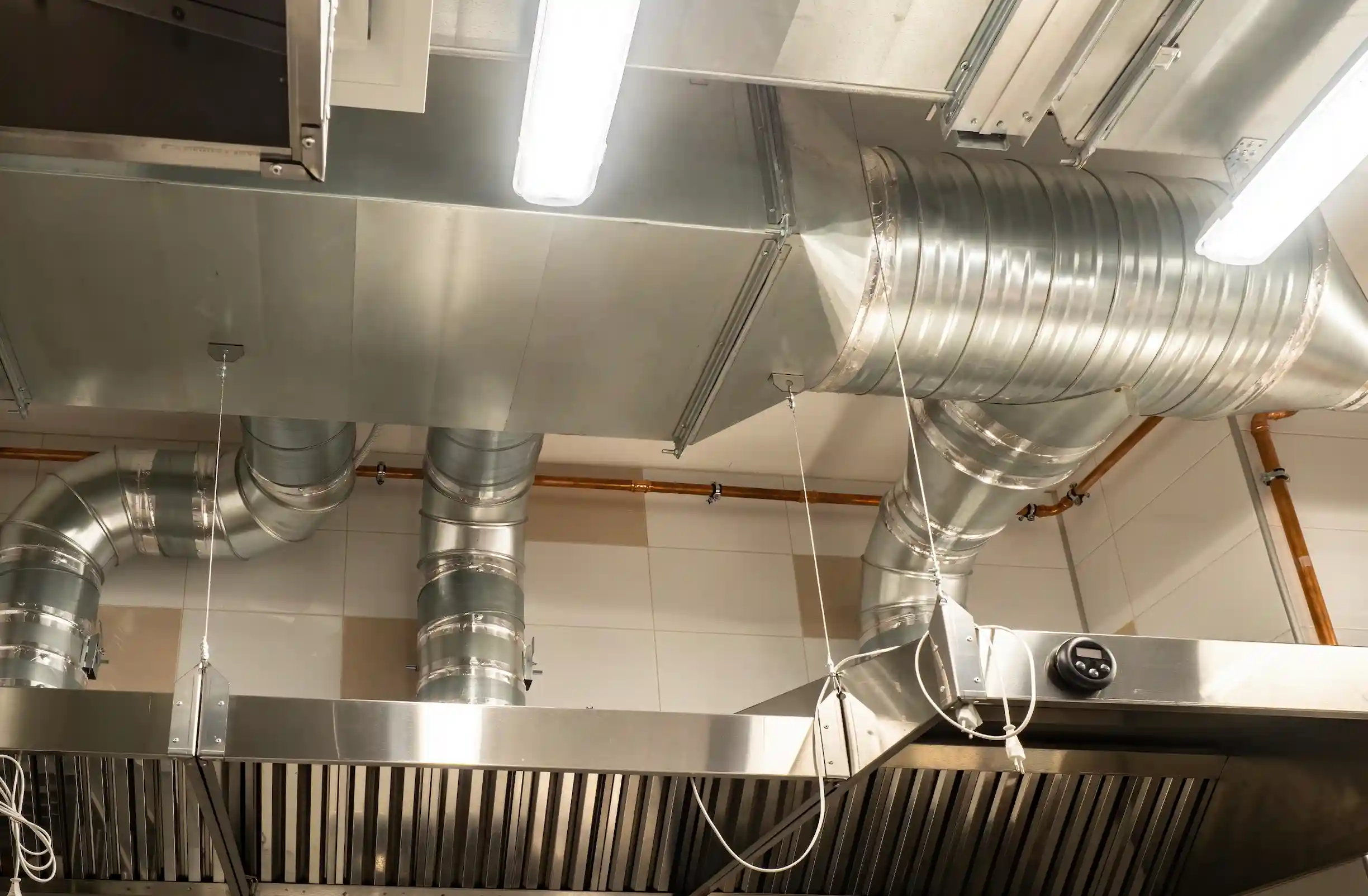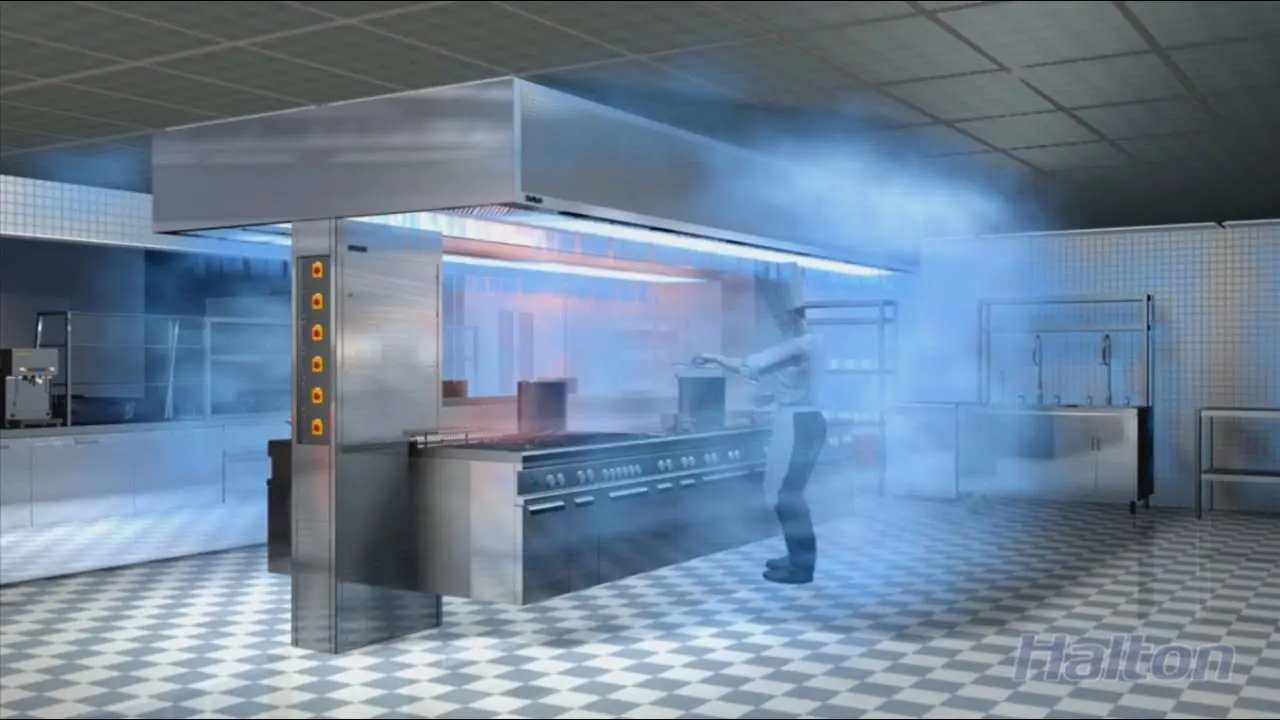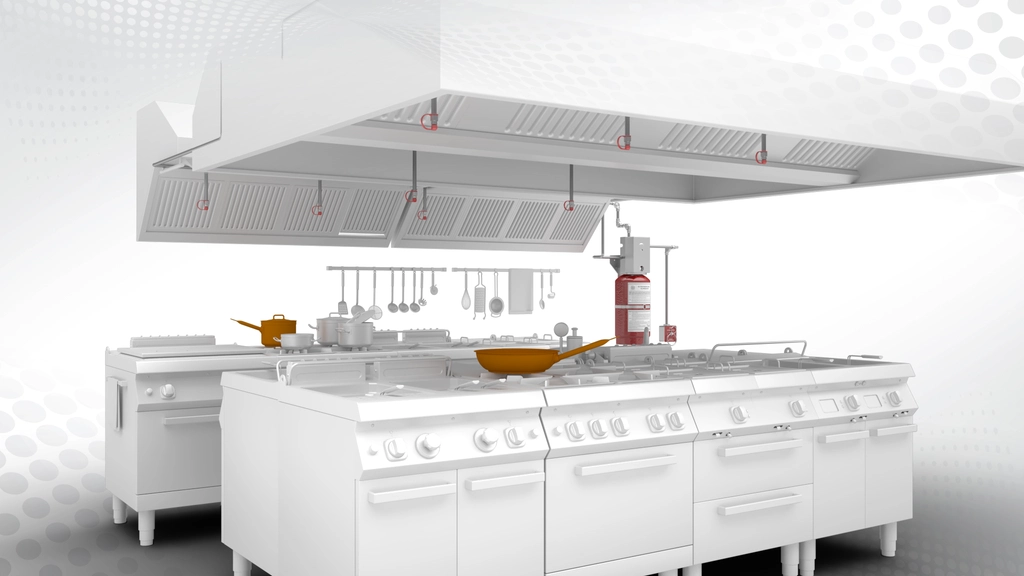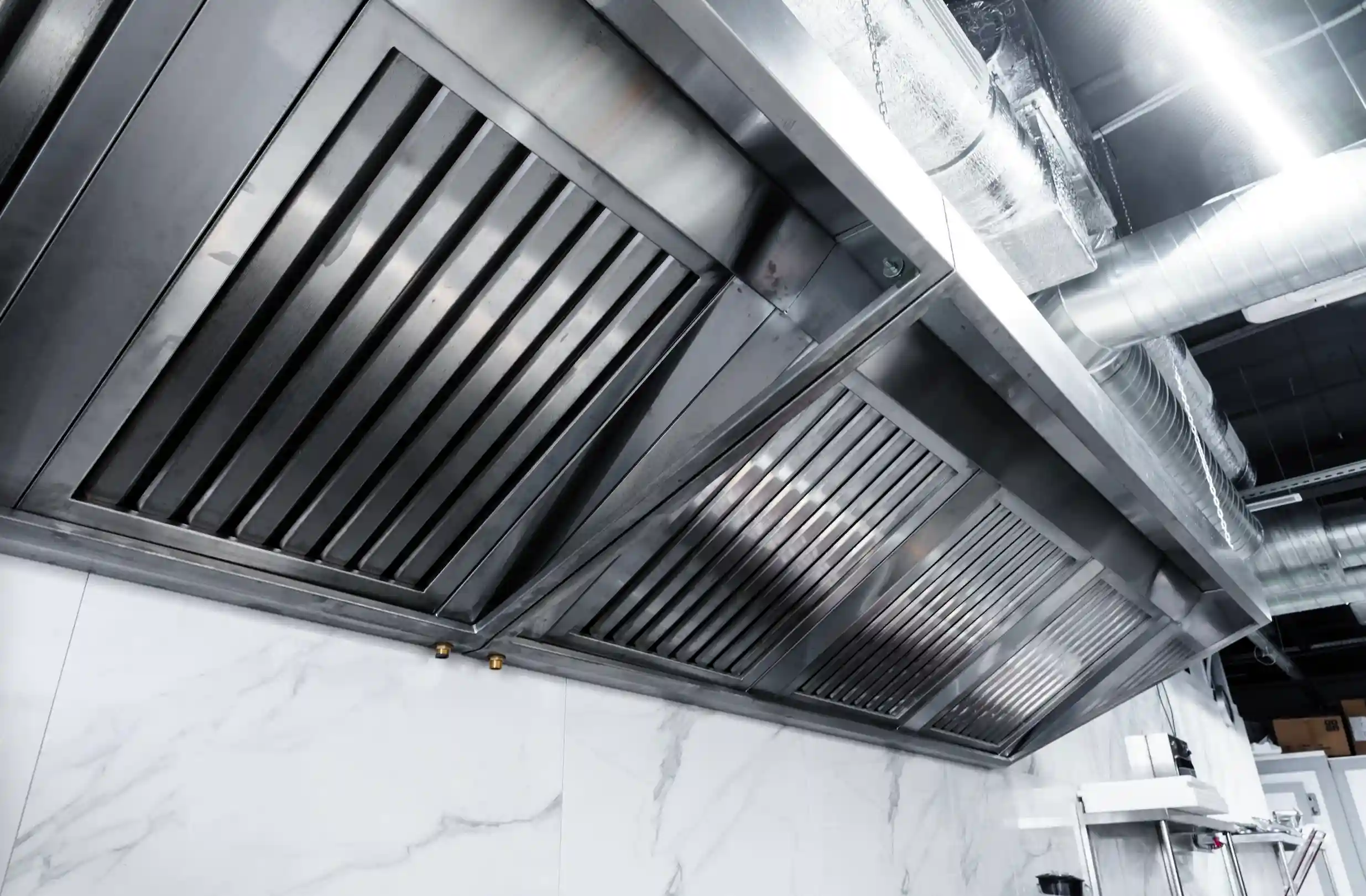
- Home
- Fire Suppression & Safety Systems – Engineered for Commercial Kitchens in Turkey
Extraction Hoods Made in Turkey
Fire Suppression & Safety Systems – Engineered for Commercial Kitchens in Turkey
When One Spark is Enough – Why Fire Systems Are Non-Negotiable
We’ve witnessed it ourselves in busy à la carte kitchens and QSR chains — one unattended fryer, a slight oil spill, or a spark from a grill can ignite a full-scale fire within seconds. In less than 30 seconds, an unattended fryer can turn into a full-blown fire.
As part of our turnkey kitchen projects, we provide certified fire suppression systems, fully compatible with hood systems and international safety codes. These systems are manufactured and integrated in Turkey, trusted by contractors, consultants, and kitchen designers across 40+ countries.
Fire events happen more often than most managers think. That’s why fire protection is not just an accessory — it’s a necessity. We have seen even top-tier hotel kitchens face shutdowns due to lack of proper fire suppression systems.
1-Year Factory Warranty
Service in 90+ countries
Spare parts in Turkey, UAE
System Components – What’s Inside?
- Nozzles – Positioned inside hoods, ducts & appliances
- Wet Chemical Cylinder – Stores extinguishing agent
- Piping & Control Valves – Stainless steel, pressure-rated
- Manual Pull Station – Wall-mounted emergency trigger
- Automatic Detection Line – Fusible links melt at 93°C–260°C
- Micro-Switch Relay – Auto-shuts off gas or electricity
Even these components might seems simple, theys actually are the first line of defense between your kitchen and a total disaster.
Integration with Hood & Ventilation Systems
Your fire suppression system isn’t complete unless it syncs with your ventilation. That’s why we pre-engineer all solutions to be compatible with hood exhaust volume, duct positions, and make-up air systems. The goal: zero interference, full protection.
This integration is especially critical in open kitchen designs where smoke and flame control must be invisible yet instant.
Ansul R-102 vs Ansul Piranha – Which One for Your Kitchen?
Feature | Ansul R-102 | Ansul Piranha |
System Type | Wet chemical | Dual agent (wet + water mist) |
Cooling Power | Standard | 🔥 Faster cooldown |
Ideal Use | Standard kitchens, QSRs | High-risk zones, solid fuel cooking |
Water Line Needed? | ❌ Not required | ✅ Required |
Installation | Simple, retrofit-friendly | More complex, dual setup |
Cost Range | 💰 More budget-friendly | 💰💰 Higher, but safer |
Best For | Gas fryers, standard hoods | Charcoal grills, heavy grease appliances |
✅ Quick Tip: Choose Piranha for extra protection in high-heat or solid fuel kitchens. Stick with R-102 for standard gas or electric setups.
Before & After Suppression Activation
In one real-life project, a kebab restaurant in Istanbul experienced a minor grease fire that escalated. Upon activation, the Ansul wet chemical system instantly blanketed the flames and cooled down the equipment. The fire was contained in under 8 seconds — no damage to the hood or ductwork.
Before activation, thick smoke started covering the kitchen. After suppression, visibility restored in less than 20 seconds. Staff was shocked how fast it work.
Downtime Calculator – Cost of Not Having a System
A study showed that a single day of restaurant closure due to fire can cause over €2,300 in lost revenue. Add to that repair costs, staff downtime, and equipment loss, and it’s easy to see why installing suppression is a tiny price to pay.
Example: One bakery in Berlin without a suppression system faced a 4-day closure — total loss: €9,800 + equipment replacement.
Even worse, their insurance coverage delayed for weeks because the kitchen lack certified suppression. Don’t make same mistake.

🧪 Grease Fire Behavior Simulation
In commercial kitchens, grease fires escalate quickly. During a simulation at our Istanbul test center, we saw how an unattended fryer reached flashpoint within 40 seconds. Flames reached the hood filters in just 12 more seconds.
🔥 Key takeaway: Every second counts. Don’t wait until smoke fills your dining room.
🧼 Maintenance Tips – Easy Steps That Prevent Disaster
- Test detection line monthly (replace fusible links every 6–12 months)
- Clean nozzles and replace filter caps
- Check pressure gauge on cylinder weekly
- Train kitchen staff to use manual pull station
Missed maintenance can break your system when needed most. And that could means permanent closure.
🖼️ Thermal Imaging – Fire Response Time Visualized
Thermal cameras show critical data. During our tests, suppression systems like Ansul R-102 reduced core flame temperatures from 400°C to below 100°C in 8 seconds. That speed prevents hood warping, duct damage, and appliance loss.
These images convince many consultants and insurance firms to make suppression systems mandatory.
🧯 System Lifecycle & Recharging
Fire suppression systems aren’t install-and-forget. Wet chemical cylinders must be recharged every 6 or 12 months — and we’ll remind you before it expires.
We also offer annual fire tests and system health check-ups, ensuring the system won’t fail when it matters most.
🤖 Smart System Integration & Automation
From IoT sensors to smart pressure detection and real-time alerts, today’s systems can talk to each other. Our setups allow your exhaust fans, make-up air units, and fire suppression cylinders to operate in sync — improving safety and reducing manual errors.
Automation means: less human error, more control, better protection.
🔬 Technology Behind the Systems
We often get asked: “What makes one suppression system better than another?” The answer lies in the details — spray angles, cooling rate, fuse temperature, air displacement flow…
We test all parameters under lab conditions and offer only the models that show consistent and fast response in real kitchen environments.
🔧 Maintenance Contracts & Long-Term Support
Once installed, your system needs attention. That’s why we offer long-term service contracts including 6-month cylinder refills, annual testing, and emergency support.
We’re here after installation — because fire safety is never one-time job.
🌍 Global Applications & Use Cases
🏨 Luxury Hotels – Multi-zone suppression in Dubai 5-star resorts
🍗 Fast Food Chains – Compact under-hood systems in Nairobi and Cairo
🏥 Healthcare – Piranha systems in hospital kitchens with solid fuel ovens
We adapt to different regulation worldwide, from NFPA 96 to local European norms.
🛠️ Consultant Support – Tender-Ready Layout Help
Need layout diagrams for tender docs? We work with consultants and procurement teams worldwide to prepare specs, quantities, and certifications.
Just send us your equipment list and hood dimensions. We’ll do the rest.
🧪 Certification & International Compliance
All our systems are manufactured in compliance with UL 300, NFPA 96, CE, and EN 16282-6 standards. Every fire system we deliver comes with CE conformity and can be customized for local code requirements. From Dubai to Berlin, we adapt to your region’s laws.

Installation & Utility Requirements
- Power: 230V standard for control system
- Mounting: Inside hood canopy or ceiling
- Water Line: Only needed for Piranha systems
- Certification: UL300, EN 16282-6, NFPA 96 compliant
Make sure all components are installed by licensed technician. A wrong nozzle angle can risk the entire system effectiveness.
❓ FAQ – Fire Suppression Systems for Commercial Kitchens
What’s the difference between Ansul R-102 and Piranha systems?
R-102 is a wet chemical-only system, ideal for standard gas/electric kitchens. Piranha adds water mist for faster cooldown, making it better for solid fuel or charcoal-heavy operations.
Do fire suppression systems integrate with my hood and ventilation?
Yes. We pre-engineer all systems to align with your hood airflow, ducting, and make-up air, ensuring smooth operation and zero conflicts.
How often do cylinders need recharging?
Typically every 6–12 months. We provide reminders and maintenance contracts so you don’t miss critical servicing.
Can I retrofit suppression into an existing kitchen?
Absolutely. Most models are retrofit-friendly. We review your hood type, cooking load, and duct space to design a seamless upgrade.
Are these systems internationally certified?
Yes. All units comply with UL 300, NFPA 96, CE, and EN 16282 standards, making them globally acceptable for hotel, healthcare, and restaurant projects.
Real Projects & Client Testimonials – What Our Partners Say



